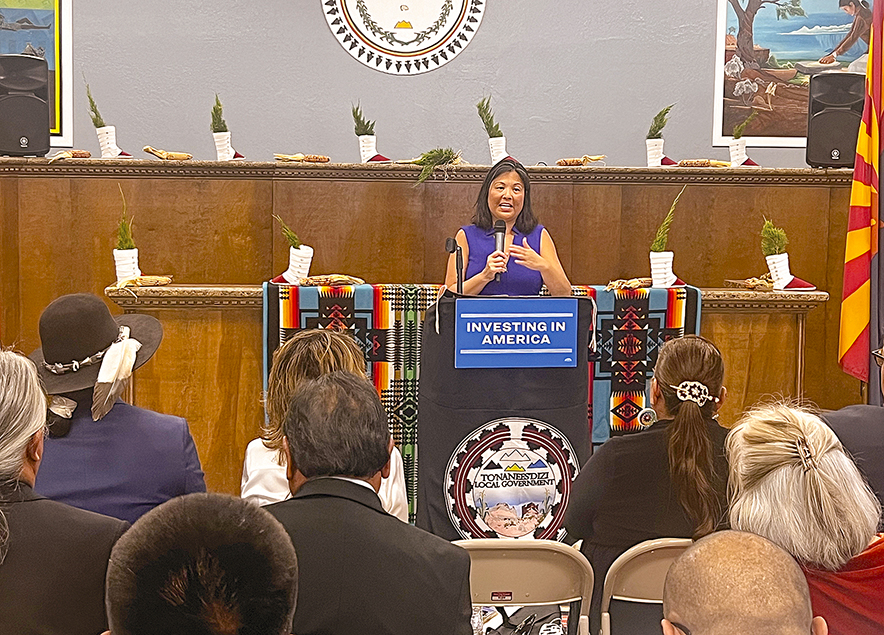
Acting Labor Secretary Julie Su visits Tuba City job fair

Special to the Times | Paul Garcia
Acting Secretary of Labor Julie Su is gifted a Pendleton blanket Aug. 7 at the “DOL Day: Investing in Navajo Nation” job fair that was held at the Tuba City Chapter House.
By Paul Garcia
Special to the Times
FLAGSTAFF – Acting Secretary of Labor Julie Su met with Navajo Nation President Buu Nygren and other tribal leaders on Wednesday, Aug. 7 at the “DOL Day: Investing in Navajo Nation” job fair that was held at the Tuba City Chapter House.
The visit was part of Acting Secretary Su’s two-day itinerary in Arizona to discuss the importance of creating a strong job market and the department’s ongoing efforts to help Americans find support and resources in their communities.

Special to the Times | Paul Garcia
Acting Secretary of Labor Julie Su speaks before a crowd at the “DOL Day: Investing in Navajo Nation” job fair at the Tuba City Chapter in Tuba City on Aug. 7.
Economic insecurity has been an issue that has long plagued the Navajo Nation. According to the U.S. Census Bureau, the medium income for Navajo citizens was $33,000 in 2022 and an estimated 35% of people living in the Navajo Nation fell below the poverty line. One of the factors that contributes to the level of poverty in the Navajo Nation is the scarcity of jobs available.
“We know that in order for community to stand up and rise … we really need strong economic activity,” said President Nygren. “We need jobs, we need small businesses, we need access to financing, and we need leadership to really support and move some of those initiatives.”
President Nygren also briefly touched on several key issues that he hopes to improve with the aid of the Department of Labor, such as improving data and statistic collection across the Navajo Nation and work site safety. He also hopes to create partnerships between national agencies with their Navajo counterparts such as the Occupational Safety and Health Administration and NOSHA in the Navajo Nation.
He also hopes to use the Workforce Innovation and Opportunity Act to provide tribe members with pathways to careers through apprenticeships and other training programs.
“Everybody knows that good jobs change lives,” said Acting Secretary Su. “A good job is the pathway to opportunity; it is the way people become secure enough to live … not just for today but into the future and for generations to come.”
As part of its ongoing mission “to foster, promote, and develop the welfare of the wage earners, job seekers, and retirees of the United States,” the DOL has a campaign called “Yes WIOA can” that aims to bolster the workforce in the U.S. while also centering equity. It also helps dispel perceived barriers that may discourage applicants from pursuing funding. For tribal leaders, it helps clarify which funds are eligible for them.
Recently, the Navajo Department of Workforce Development deployed $13 million that was secured through WIOA for workforce training. President Nygren hopes to allocate some of the funds for a workforce training facility on the Navajo Nation. Acting Secretary Su acknowledges the efforts of the NDWD to mobile the workforce. She also stressed the importance of their role in connecting employers with potential workers.
“We need to make sure that training programs lead to actual jobs,” Acting Secretary Su said. “That’s part of the opportunity infrastructure. We want to make sure that education institutes, their courses, their degrees, their credentials, are tied to good jobs at the end of them.”
Another topic that was brought up was the need for updating existing infrastructures in the Navajo Nation. As well as creating new infrastructure for upcoming projects to uplift the community such as renewable energy and solar energy projects.
“One of the things that President Biden’s Investing in America agenda is all about is making sure that we are putting money and resources into communities, including those that we left out in the past,” said Acting Secretary Su. “We want to make sure that when we are building infrastructure in communities, those communities are the ones who get the good jobs to build them.”
Investing in America is part of the Biden-Harris Administration agenda to revitalize the economy and job market through existing legislation such as the American Rescue Plan, the Bipartisan Infrastructure Law, the CHIPS and Science Act, and the Inflation Reduction Act. Through the Investing in America agenda, $15.4 billion has already been directed toward infrastructure projects in Arizona alone and has created over 350,000 jobs as of June 2024.








 Highway 264,
Highway 264, I-40, WB @ Winslow
I-40, WB @ Winslow